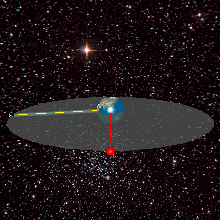
Back Geostasionêre wentelbaan Afrikaans Orbita cheoestacionaria AN مدار جغرافي ثابت Arabic Órbita xeoestacionaria AST Geostasionar orbit Azerbaijani Геастацыянарная арбіта Byelorussian Геастацыянарная арбіта BE-X-OLD Геостационарна орбита Bulgarian ভূস্থির কক্ষপথ Bengali/Bangla Orbitenn geoarsavel Breton




A geostationary orbit (or Geostationary Earth Orbit - GEO) is a type of geosynchronous orbit directly above the Earth's equator (0° latitude). Like all geosynchronous orbits, it has a period (time for one orbit) that is 24 hours. This means it goes around the Earth as fast as the Earth spins, and so it appears to stay above the same spot all the time. A person watching from Earth sees a satellite in a geostationary orbit as not moving, at a steady place in the sky.